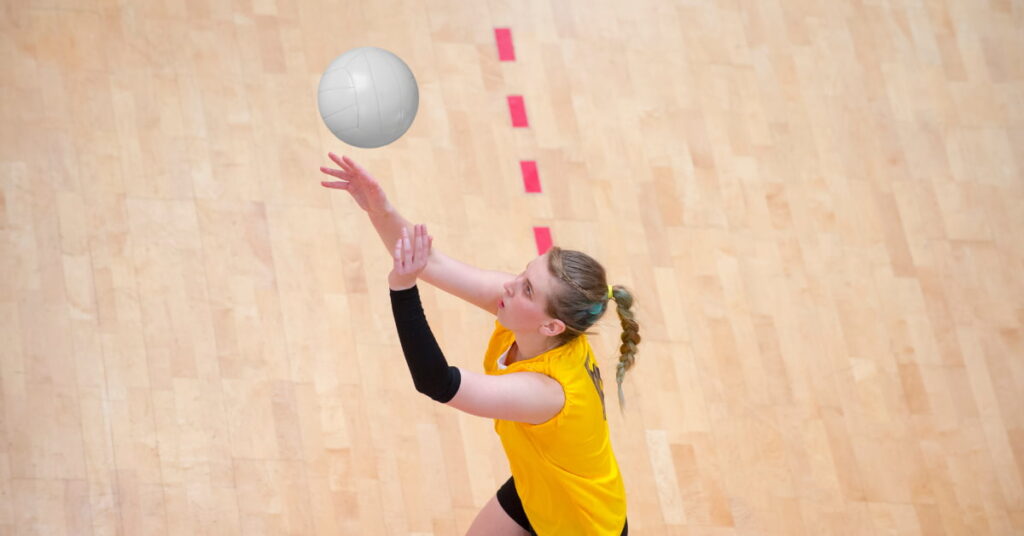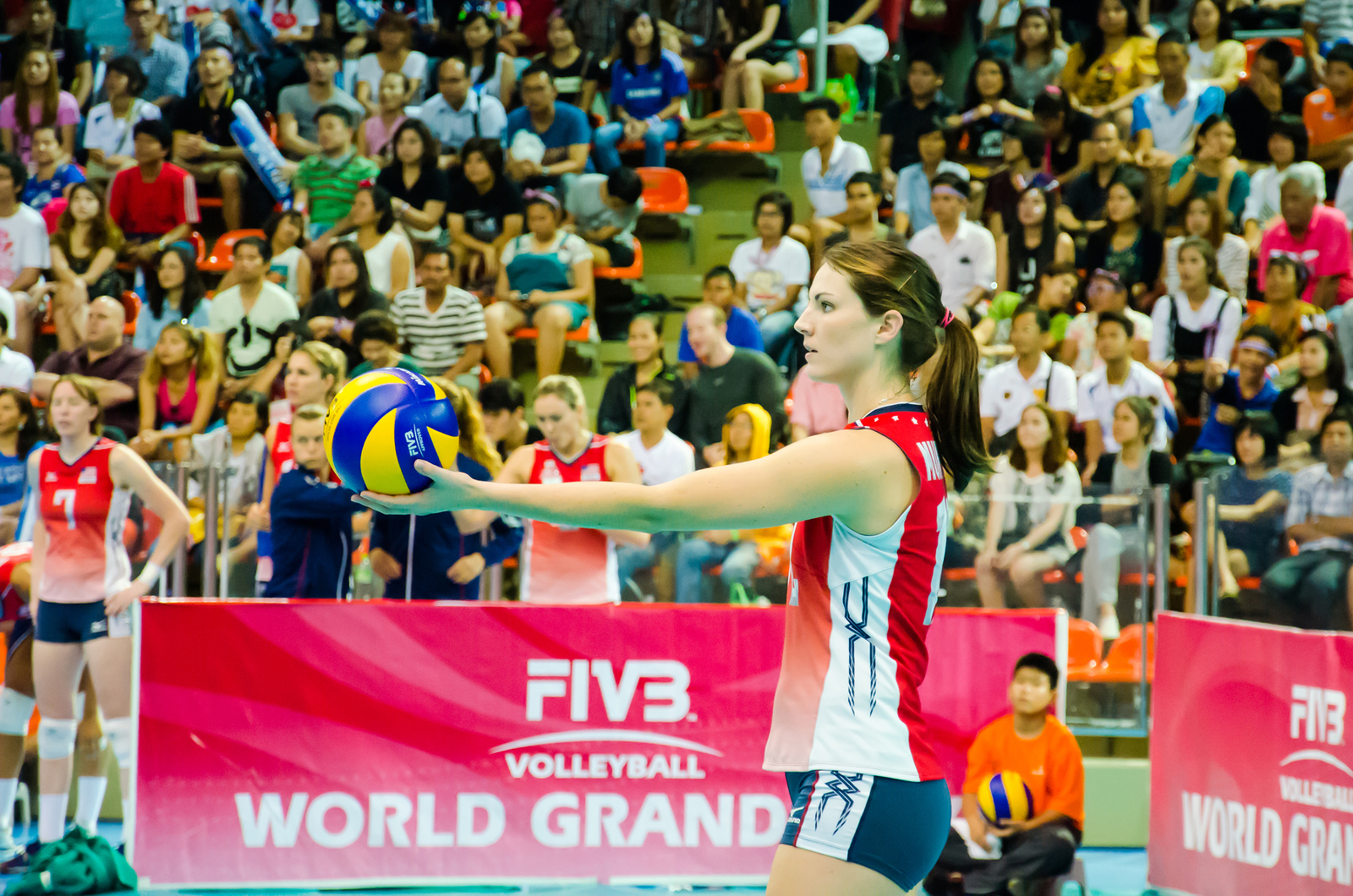In the exhilarating world of volleyball, the ability to execute a ‘service ace’ can be a game-changer, setting apart the good players from the exceptional ones. But what exactly is a service ace in volleyball, and how can one master this skill that combines precision, power, and strategic thinking?
This comprehensive guide will unravel the intricacies of the service ace, exploring its benefits, the associated rules, and the strategies you can use to maximize your chances of delivering a winning service. We’ll also highlight common mistakes to avoid, paving your way to becoming a formidable opponent on the court.
What Does A Service Ace Mean In Volleyball?
A service ace in volleyball refers to a serve that results directly in a point without the receiving team being able to make a legitimate return. This could occur due to factors such as the serving player’s power and precision, the serve’s unexpected direction, or an error on the part of the receiving team. The term ‘ace’ is derived from tennis, which refers to a similar situation – a serve that the receiver cannot touch. In both sports, an ace represents a significant achievement, showcasing a player’s serving prowess and providing a crucial edge in the competition.
How to Perform a Service Ace?
Several elements need to be considered to execute a successful service ace – the serving technique, ball placement, and timing. Here’s a step-by-step guide to help you:
- Adopt the right stance: Stand with your feet shoulder-width apart, knees slightly bent. If you’re right-handed, your left foot should be slightly in front, and vice versa.
- Grip technique: Hold the ball in your non-dominant hand, keeping it at waist level. Your dominant hand should grip the ball as if you were reaching for a handshake. Fingers spread wide, and wrist flexible.
- The toss: Toss the ball high into the air – the ideal height is around 18 inches above your reach. The toss should be in front of your hitting shoulder, slightly toward your target court.
- The hit: As the ball descends, swing your hitting arm forward in a whip-like motion, hitting the ball with the heel of your hand. Aim to hit the ball at the highest point of your reach, directing it to the weak zone of your opponents.
- Follow-through: Follow through with your swing, allowing your hand to continue its motion towards the ground naturally. This will give your server more power and direction.
Remember, practice makes perfect. Regular drills focusing on these aspects can enhance your serving skills, increasing the likelihood of scoring aces.

Benefits of Achieving A Service Ace
Achieving a service ace in volleyball provides several key advantages that can significantly impact the outcome of a game. Firstly, it directly contributes to your team’s score, inching you closer to victory. Secondly, a successful service ace can boost the morale and confidence of the player and the team, fostering a positive and energetic game environment.
Moreover, frequently serving aces can put psychological pressure on the receiving team, causing them to anticipate and fear your serves, which can lead to mistakes on their part. Lastly, a service ace saves energy, resulting in a point without needing a full-fledged rally. This allows players to conserve their stamina for more strenuous parts of the game. Consequently, mastering the service ace can be a strategic move that enhances your team’s performance and competitive edge.
Rules Related to Serving Aces
While serving aces can be a powerful tool in a player’s arsenal, it’s crucial to be aware of the rules surrounding serves in volleyball to ensure your serve is deemed legal. Here are some key rules to remember:
- Server’s position: During the serve, the player must position themselves behind the end line and within the service area boundaries until contact is made with the ball.
- Service order: The serving order established at the start of the match must be followed throughout the game. The right to serve is determined by a coin toss initially and then continues in a clockwise rotation.
- Ball contact: The ball must be cleanly hit, not caught, lifted or thrown. The service may be made underhand or overhand.
- Service faults: A service is considered a fault if it doesn’t pass over the net, goes out of bounds, passes over a screen, or hits an antenna, the ceiling, or a teammate.
- Service lets: In volleyball, there are no ‘lets’. If the ball touches the net on the serve but still lands in the opponent’s court, it’s considered a legal serve, and play continues.
Understanding these rules is essential to execute a legal and practical service ace. Violating these rules would result in a fault, causing your team to lose the serve and providing the opposing team with a point. Therefore, mastering the rules is as important as learning the service itself.
Strategies for Maximizing Your Chances of Achieving a Service Ace
To increase your chances of scoring an ace, it is essential to develop a serving strategy that leverages your strengths and capitalizes on your opponent’s weaknesses. Here are some strategies that can help maximize your potential to achieve a service ace:
- Vary your serves: Change your serving style and direction now and then. This will keep the receiving team guessing, making it more challenging for them to predict and return your serves.
- Identify weak receivers: Pay attention to the opponents’ receiving patterns. If a player struggles with certain types of serves or specific directions, target these areas to increase your chances of scoring an ace.
- Serve to deep corners: Deep corners are often tricky for receivers to reach, especially if they need to be positioned correctly. Practice serving these areas to put your opponents under pressure.
- Master the float serve: A float serve, where the ball moves unpredictably in the air, can be hard to receive. Work on your float serve technique to increase your chances of scoring aces.
- Focus on precision, not just power: While a powerful serve can be challenging to return, a well-placed serve can be equally effective. Aim to serve to areas of the court that are hard for your opponents to reach, irrespective of their positioning.
- Mental preparation: Volleyball is as much a mental game as it is a physical one. Before serving, take a moment to visualize your serve and the desired outcome. This can help increase your focus and reduce anxiety.
By incorporating these strategies, you can enhance your serving game, making you a more formidable player and increasing your chances of achieving a service ace.
Common Mistakes When Attempting To Serve an Ace
While attempting to serve an ace in volleyball, players often make certain common mistakes that can drastically reduce their chances of success. Recognizing and avoiding these errors can significantly improve your serving accuracy and effectiveness.
- Inconsistent Toss: An erratic toss can throw off the timing of your serve, resulting in a miss-hit or a serve that goes out of bounds. Practice consistent and controlled tosses to ensure a clean hit every time.
- Neglecting to Scout the Opposition: It’s crucial to analyze the receiving team’s formation and identify their weak receivers before serving. You miss opportunities to score aces if you serve without considering your opponent’s positioning and weaknesses.
- Poor Body Positioning: Your body alignment during the serve plays a critical role in determining the direction and power of your serve. Incorrect body positioning can lead to serves that lack power or go off target.
- Relying Solely on Power: While a powerful serve can be challenging to return, precision and placement are often more effective. Relying solely on power without focusing on accuracy can result in more missed serves.
- Lack of Variety: Repeatedly serving in the same manner or direction makes your serve predictable, allowing the receiving team to adjust and return your serves more effectively. Incorporating variety in your serves can keep your opponents guessing.
- Not Following Through: A proper follow-through ensures the momentum of your swing carries through the ball, providing power and direction to your serve. Remembering to follow through can prevent your serve from falling short or going off target.
By being mindful of these common mistakes and working to correct them, you can significantly improve your serving game and increase your chances of scoring service aces.

Frequently Asked Questions
What are the key rules for serving in volleyball?
The fundamental rules for serving in volleyball include:
- Standing within the service area and behind the end line until the ball is contacted.
- Adhering to the serving order established at the start of the match.
- Ensure the ball is cleanly hit and not caught, lifted, or thrown.
- Ensuring the serve goes over the net and lands within the boundaries of the opponent’s court.
How many points is a service ace in volleyball?
A service ace in volleyball is worth one point.
Why is variety in serves important for scoring aces?
Variety in serves is crucial for scoring aces in volleyball because it makes your serves unpredictable and challenging for the receiving team to anticipate. By changing your serve’s speed, spin, or direction, receivers cannot settle into a rhythm or pattern, making it harder to position themselves correctly for the return. This unpredictability can increase service aces, as the opponent may struggle to receive and return diverse and unpredictable serves effectively.
Who is awarded the Ace in Volleyball?
In volleyball, an ace is awarded to the server when the serve lands on the opponent’s side untouched. It’s also counted as an ace if the opposing team touches the ball, but fails to return it legally.
What is a service error in volleyball?
A service error in volleyball occurs when the server violates the serving rules or fails to execute the serve successfully. This can include situations such as the ball hitting the net and not going over, the ball going out of bounds, stepping over the end line before the ball is hit, or serving out of turn. Each service error results in a point for the opposing team and a loss of the serve for the server’s team. Understanding and avoiding service errors is crucial to maintaining serve and scoring points in volleyball.
How can mental preparation influence the outcome of a serve?
Mental preparation can significantly influence the outcome of a serve in volleyball. It’s not just about physical skill; your mindset before and during the serve can impact its direction, power, and accuracy. Before serving, it’s beneficial to visualize the serve’s trajectory and where you want the ball to land on the opponent’s court. This mental imagery helps increase focus, reduces anxiety, and can result in a more successful serve.
What is a float serve in volleyball?
A float serve in volleyball is a type where the ball is hit without spin, causing it to move unpredictably in the air, similar to a knuckleball in baseball. This unpredictability can make it difficult for the receiving team to accurately judge the ball’s trajectory and speed, increasing the server’s chances of scoring a point.
Conclusion
Achieving a service ace in volleyball requires technical skill, strategic understanding, and mental preparation. Understanding the common mistakes made when attempting to serve an ace and working diligently to avoid them can significantly enhance your serving game. It’s essential to focus on power and accuracy, variety, and placement of the serve. Remember, each serve is not just an opportunity to score but also a chance to put the opposing team under pressure. With practice, mindfulness, and perseverance, you can increase your chances of scoring service aces and becoming a more formidable player in the game.



